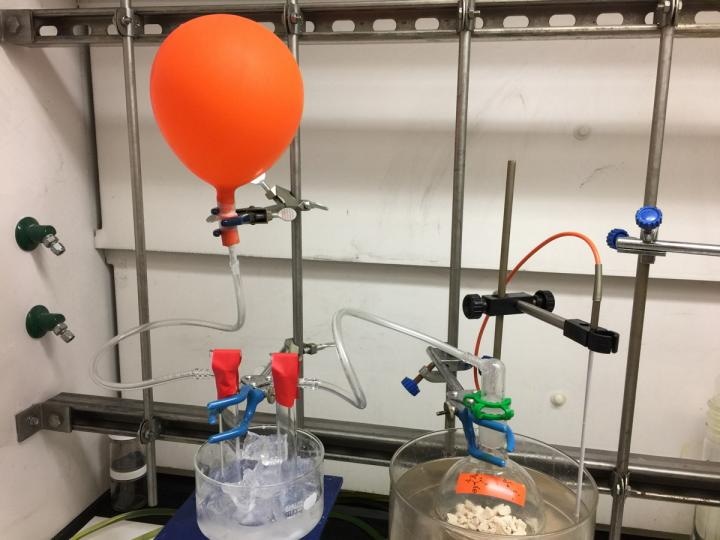Feb 1 2019
Researchers at the Department of Energy’s Oak Ridge National Laboratory (ORNL) have created a process that eliminates CO2 from coal-burning power plant emissions just like how soda lime functions in scuba diving rebreathers.
 This image shows CO2 being released by mild heating of the BIG-bicarbonate solid. The released CO2 gas is trapped in the orange balloon, while the released water vapors are trapped by condensation in the ice-cooled U-shaped tube. (CREDIT: Neil J. Williams and Erick Holguin)
This image shows CO2 being released by mild heating of the BIG-bicarbonate solid. The released CO2 gas is trapped in the orange balloon, while the released water vapors are trapped by condensation in the ice-cooled U-shaped tube. (CREDIT: Neil J. Williams and Erick Holguin)
Their work, reported in the journal Chem on January 31st, 2019, provides an alternative yet simpler approach for carbon capture and uses 24% less energy when compared to industrial benchmark solutions.
Soda lime, a solid off-white mixture of calcium and sodium hydroxides, is used to avoid the poisonous accumulation of CO2 gas in closed breathing environments such as submarines, scuba rebreathers, and anesthesia. The mixture behaves as a sorbent (a substance that collects other molecules), transforming into calcium carbonate (limestone) as it amasses CO2. The CO2 scrubber developed by ORNL team to treat CO2-rich flue gas emitted by coal-burning power plants basically works in the same way; however, it was not always their aim to advance carbon-capture technology.
We initially stumbled into this research by accident.
Radu Custelcean, Research Scientist, ORNL.
Radu Custelcean is also the senior author of the study.
Recently, Custelcean and his group “rediscovered” a class of organic compounds known as bis-iminoguanidines (BIGs), which were first described by German researchers during the end of the 20th century and recently became famous for their potential to selectively bind anions (negatively charged ions). The researchers recognized that the potential of compounds to unite and separate anions could be applied to bicarbonate anions, which resulted in the development of a CO2-separation cycle with the help of an aqueous BIG solution.
Their carbon-capture technique enables the flue gas to be bubbled through the solution, making CO2 molecules to bind to the BIG sorbent and crystallize into a kind of organic limestone. This solid can subsequently be filtered out of the solution and heated at 120 ○C to eliminate the CO2 so it can be sent to permanent storage. After that, the solid sorbent can be dissolved in water and reused in the process for quite long.
Modern carbon-capture technologies have major faults. Most of them use liquid sorbents, which evaporate or decompose and over 60% of regeneration energy should be spent to heat the sorbent. The technology developed by ORNL team overcomes these challenges since their method involves capturing CO2 as a crystallized bicarbonate salt and releasing it from the solid state rather than heating a liquid sorbent. Their twist on carbon capture needs 24% less energy when compared to industrial benchmark sorbents. Additionally, the team observed nearly no sorbent loss following 10 consecutive cycles.
The main advantage of our ‘organic soda lime’ is that it can be regenerated at much lower temperatures and with significantly less energy consumption compared to inorganic scrubbers. The lower energy required for regeneration is expected to significantly reduce the cost of carbon capture, which is critical considering that billions of tons of CO2 need to be captured every year to make a measurable impact on the climate.
Radu Custelcean, Research Scientist, ORNL.
Although the process is still in its initial stages, Custelcean and his colleagues hope that it will be finally scalable. However, the approach indeed has an obstacle to combat with—its comparatively low CO2 capacity and absorption rate, which arise from the restricted solubility of the BIG sorbent in water.
“We are currently addressing these issues by combining the BIG sorbent with traditional sorbents, such as amino acids, to enhance the capacity and absorption rate,” says Custelcean. “We are also adjusting the process so it can be applied to CO2 separation directly from the atmosphere in an energy-efficient and cost-effective way.”
Source: http://www.cellpress.com/